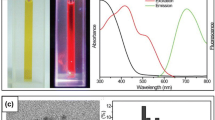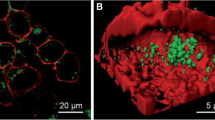Abstract
Dextrans are widely used as additives in food, pharmaceutical, and cosmetics because of their hydrophilicity, biocompatibility, and low toxicity. These features allow the use of dextrans to modify the surface of nanoparticles to improve cell compatibility for biomedical applications. Additionally, dextran molecules covalently bound with fluorescent dyes are frequently used as tracers in animal studies. These facts show that dextrans are useful compounds for biomedicine-related applications and research. Our aim was to explore a facile way to generate dextran-derived nanoparticles with photoluminescent property for the use in fluorescence imaging of bacteria and cancer cells. Dextran-encapsulated gold nanoclusters (AuNCs@dextran) were generated through a one-pot reaction by stirring dextrans and aqueous tetrachloroauric acid overnight. The generated AuNCs exhibit bright and green photoluminescence under the illumination of an ultraviolet lamp (λ max = 365 nm), and high cell biocompatibility was found as well. Therefore, the generated AuNCs can be used as fluorescence tracers and nanoprobes. We explored the suitability of AuNCs@dextran as labeling agents for bacteria, such as Staphylococcus aureus and Escherichia coli. After the bacteria were labeled by AuNCs@dextran, they became quite visible under a fluorescence microscope. Additionally, we demonstrated that nanocomposites composed of AuNCs@dextran and silica beads can be readily internalized by cancer cells. The nanocomposites can be readily detected in the cells through their photoluminescence, suggesting possible applications in drug delivery and fluorescence imaging.









Similar content being viewed by others
References
Arbab AS, Wilson LB, Ashari P, Jordan EK, Lewis BK, Frank JA (2005) A model of lysosomal metabolism of dextran coated superparamagnetic iron oxide (SPIO) nanoparticles: implications for cellular magnetic resonance imaging. NMR Biomed 18(6):383–389
Berry CC, Wells S, Charles S, Curtis ASG (2003) Dextran and albumin derivatised iron oxide nanoparticles: influence on fibroblasts in vitro. Biomaterials 24(25):4551–4557
Chan PH, Chen YC (2012) Human serum albumin stabilized gold nanoclusters as selective luminescent probes for Staphylococcus aureus and methicillin-resistant Staphylococcus aureus. Anal Chem 84(21):8952–8956
Chan PH, Wong SY, Lin SH, Chen YC (2013) Lysozyme-encapsulated gold nanocluster-based affinity mass spectrometry for pathogenic bacteria. Rapid Commun Mass Spectrom 27(19):2143–2148
Chaudhari K, Xavier PL, Pradeep T (2011) Understanding the evolution of luminescent gold quantum clusters in protein templates. ACS Nano 5(11):8816–8827
Chen WY, Lin JY, Chen WJ, Lo L, Diau EWG, Chen YC (2010) Functional gold nanoclusters as antimicrobial agents for antibiotic-resistant bacteria. Nanomedicine 5(5):755–764
Chen Y, Yang T, Pan H, Yuan Y, Chen L, Liu M, Zhang K, Zhang S, Wu P, Xu J (2014) Photoemission mechanism of water-soluble silver nanoclusters: ligand-to-metal–metal charge transfer vs. strong coupling between surface plasmon and emitters. J Am Chem Soc 136(5):1686–1689
Dreyer DR, Park S, Bielawski CW, Ruoff RS (2010) The chemistry of graphene oxide. Chem Soc Rev 39(1):228–240
Dunn KW, Sandoval RM, Kelly KJ, Dagher PC, Tanner GA, Atkinson SJ, Bacallao RL, Molitoris BA (2002) Functional studies of the kidney of living animals using multicolor two-photon microscopy. Am J Physiol 283(3):C905–C916
Ho YT, Ishizaki S, Tanaka M (2000) Improving emulsifying activity of epsilon-polylysine by conjugation with dextran through the Maillard reaction. Food Chem 68(4):449–455
Hong R, Feng B, Chen L, Liu G, Li H, Zheng Y, Wei D (2008) Synthesis, characterization and MRI application of dextran-coated Fe3O4 magnetic nanoparticles. Biochem Eng J 42(3):290–300
Hu S, Shang ZB, Wang Y, Jin WJ (2010) Dextran-coated CdSe quantum dots for the optical detection of monosaccharides by resonance light-scattering technique. Supramol Chem 22(9):554–561
Hu L, Han S, Parveen S, Yuan Y, Zhang L, Xu G (2012) Highly sensitive fluorescent detection of trypsin based on BSA-stabilized gold nanoclusters. Biosens Bioelectron 32(1):297–299
Jordan A, Scholz R, Wust P, Schirra H, Schiestel T, Schmidt H, Felix R (1999) Endocytosis of dextran and silane-coated magnetite nanoparticles and the effect of intracellular hyperthermia on human mammary carcinoma cells in vitro. J Magn Magn Mater 94(1–3):185–196
Li W, Liu H, Xu Q (2012) Extracellular dextran and DNA affect the formation of Enterococcus faecalis biofilms and their susceptibility to 2% chlorhexidine. J Endod 38(7):894–898
Liebert T, Hornig S, Hesse S, Heinze T (2005) Nanoparticles on the basis of highly functionalized dextrans. J Am Chem Soc 127(30):10484–10485
Lin YH, Tseng WL (2010) Sensing of Hg2+ and CH3Hg+ based on the fluorescence quenching of lysozyme type VI-stabilized gold nanoclusters. Anal Chem 82(22):9194–9200
Liu CL, Wu HT, Hsiao YH, Lai CW, Shih CW, Peng YK, Tang KC, Chang HW, Chien YC, Hsiao JK, Cheng JT, Chou PT (2011) Insulin-directed synthesis of fluorescent gold nanoclusters: preservation of insulin bioactivity and versatility in cell imaging. Angew Chem Int Ed 50(31):7056–7060
Liu JM, Chen JT, Yan XP (2013) Near infrared fluorescent trypsin stabilized gold nanoclusters as surface plasmon enhanced energy transfer biosensor and in vivo cancer imaging bioprobe. Anal Chem 85(6):3238–3245
Mitra S, Gaur U, Ghosh PC, Maitra AN (2001) Tumor targeted delivery of encapsulated dextran–doxorubicin conjugate using chitosan nanoparticles as carrier. J Control Release 74(1–3):317–323
Nakamura S, Kato A, Kobayashi K (1992) Enhanced antioxidative effect of ovalbumin due to covalent binding of polysaccharides. Agric Food Chem 40(11):2033–2037
Nath S, Kaittanist C, Tinkharn A (2008) Dextran-coated gold nanoparticles for the assessment of antimicrobial susceptibility. Anal Chem 80(4):1033–1038
Parisel C, Saffar L, Gattegno L, Andre V, Abdul-Malak N, Perrier E, Letourneur D (2003) Interactions of heparin with human skin cells: binding, location, and transdermal penetration. J Biomed Mater Res A 67(2):517–523
Peppas NA, Bures P, Leobandung W, Ichikawa H (2000a) Hydrogels in pharmaceutical formulations. Eur J Pharm Biopharm 50(1):27–46
Peppas NA, Huang Y, Torres-Lugo M, Ward JH, Zhang J (2000b) Physicochemical, foundations and structural design of hydrogels in medicine and biology. J Annu Rev Biomed Eng 2:9–29
Shepherd R, Robertson A, Ofman D (2000) Dairy glycoconjugate emulsifiers: casein-maltodextrins. Food Hydrocolloid 14(4):281–286
Sutherland IW (1998) Novel and established applications of microbial polysaccharides. Trends Biotechnol 16(1):41–46
Tassa C, Shaw SY, Weissleder R (2011) Dextran-coated iron oxide nanoparticles: a versatile platform for targeted molecular imaging, molecular diagnostics, and therapy. Acc Chem Res 44(10):842–852
Termeer CC, Weiss JM, Schöpe E, Vanscheidt W, Simon JC (1998) The low molecular weight dextran 40 inhibits the adhesion of T lymphocytes to endothelial cells. Clin Exp Immunol 114(3):422–426
Tether L, Turnbull J (1962) Excited states of flavin coenzymes. Influence of structural factors on the reactivity of excited flavins. Biochem J 85(3):517–523
Torii H, Tasumi M (1998) Liquid structure, infrared and isotropic/anisotropic Raman noncoincidence of the amide I band, and low-wavenumber vibrational spectra of liquid formamide: molecular dynamics and ab initio molecular orbital studies. J Phys Chem B 102(1):315–321
Xie J, Zheng Y, Ying JY (2009) Protein-directed synthesis of highly fluorescent gold nanoclusters. J Am Chem Soc 131(3):888–889
Yan L, Cai YQ, Zheng BZ, Yuan HY, Guo Y, Xiao D, Choi MMF (2012) Microwave-assisted synthesis of BSA-stabilized and HSA-protected gold nanoclusters with red emission. J Mater Chem 22:1000–1005
Acknowledgments
We thank the Ministry of Science and Technology of Taiwan (NSC 101-2627-M-009-004 and NSC 102-2113-M-009-019-MY3) for the financial support of this study.
Author information
Authors and Affiliations
Corresponding author
Additional information
Wei-Ju Chiu and Wei-Yu Chen have contributed equally to this work.
Electronic supplementary material
Below is the link to the electronic supplementary material.
Rights and permissions
About this article
Cite this article
Chiu, WJ., Chen, WY., Lai, HZ. et al. Dextran-encapsulated photoluminescent gold nanoclusters: synthesis and application. J Nanopart Res 16, 2478 (2014). https://doi.org/10.1007/s11051-014-2478-z
Received:
Accepted:
Published:
DOI: https://doi.org/10.1007/s11051-014-2478-z




